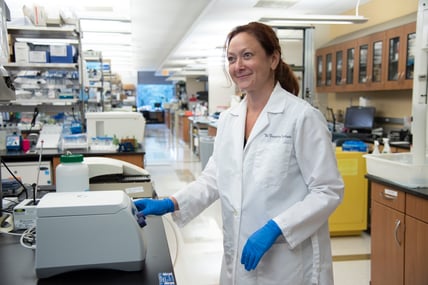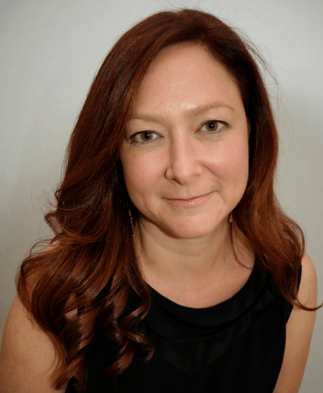 Ona Bloom, Ph.D., didn’t set out to study spinal cord injury. She wasn’t even leaning toward a degree in science. But while pursuing a History degree at Barnard College, Dr. Bloom discovered a passion for biology when she took a prerequisite science course.
Ona Bloom, Ph.D., didn’t set out to study spinal cord injury. She wasn’t even leaning toward a degree in science. But while pursuing a History degree at Barnard College, Dr. Bloom discovered a passion for biology when she took a prerequisite science course.
“I lacked confidence and I knew nothing about how to keep a lab notebook or run experiments, but I had a fabulous professor who really sparked my interest in biology,” Dr. Bloom says. “And Barnard provided tremendous infrastructure to support and encourage women entering science.”
Bloom earned a Ph.D. in neuroscience at Rockefeller University under the mentorship of Paul Greengard, Ph.D., a Nobel Laureate in Physiology or Medicine in the year 2000, where she studied the molecular structure of synapses, the points of communication between nerve cells. Now the director of the Laboratory of Spinal Cord Injury Research and a professor at the Feinstein Institutes for Medical Research and the Zucker School of Medicine at Hofstra Northwell, Dr. Bloom is advancing the field of SCI by focusing on the immune system.
Investigating the Lamprey
During her first year of graduate school, Dr. Bloom learned that an ancient animal, the lamprey, had gigantic synapses in their spinal cords. “I read that lamprey spontaneously regenerate their spinal cords after a complete transection — something that mammals haven’t figured out how to do,” she says.
Intrigued, Dr. Bloom tucked that information in the back of her mind. A few years later, she went on to pursue a postdoc in immunology in the lab of Dr. Ira Mellman, then at the Yale University School of Medicine, where she investigated the concept of an “immunological synapse,” analogous to a neuronal synapse. Just as neurons send signals to one another that trigger a response, immune cells also have the ability to share information to achieve a certain end goal.
Dr. Bloom set out to understand how immune cells communicate with each other and where that messaging takes place. She attended a lecture by the preeminent immunologist, Dr. Max Cooper, now a professor at Emory University, where she learned he was using the lamprey to study the origin of the vertebrate immune system.
“I thought, wow, these animals have this ability to regenerate and yet they have the fundamentals of a vertebrate immune system,” she says. “That stuck with me because we know that the body’s natural inflammatory response after a spinal cord injury can be deleterious to healing in mammals.”
Understanding the Immunological Consequences of SCI
 When Dr. Bloom started her own lab at the Feinstein Institute, she was surrounded by leading specialists in immunology, neuroscience, spinal cord injury and trauma. “It was an ideal place to think about how I can use my background in neuroscience and immunology to contribute to the field of spinal cord injury,” says Dr. Bloom. And she began by studying the lamprey to learn more about regeneration.
When Dr. Bloom started her own lab at the Feinstein Institute, she was surrounded by leading specialists in immunology, neuroscience, spinal cord injury and trauma. “It was an ideal place to think about how I can use my background in neuroscience and immunology to contribute to the field of spinal cord injury,” says Dr. Bloom. And she began by studying the lamprey to learn more about regeneration.
Over time, Dr. Bloom built collaborations with her clinical colleagues and began doing studies of inflammation and the immune system in individuals with either acute or chronic SCI. The reason: It has become increasingly apparent that there are severe immunological consequences for people with SCI.
“Infections are a leading cause of death and rehospitalization for people with SCI,” Dr. Bloom says. “And when people with SCI develop an infection, it not only impacts their health, but it also impacts their ability to participate in rehab and regain functional mobility.” There’s evidence to suggest that chronic inflammation inhibits plasticity and promotes medical consequences, like cardiovascular disease and stroke.
“Our goal is to understand what’s different about the immune system after an injury and determine how we might be able to modify the immune system to improve functional abilities, life expectancy, and quality of life,” Dr. Bloom says.

 Ona Bloom, Ph.D., didn’t set out to study spinal cord injury. She wasn’t even leaning toward a degree in science. But while pursuing a History degree at Barnard College, Dr. Bloom discovered a passion for biology when she took a prerequisite science course.
Ona Bloom, Ph.D., didn’t set out to study spinal cord injury. She wasn’t even leaning toward a degree in science. But while pursuing a History degree at Barnard College, Dr. Bloom discovered a passion for biology when she took a prerequisite science course. When Dr. Bloom started her own lab at the Feinstein Institute, she was surrounded by leading specialists in immunology, neuroscience, spinal cord injury and trauma. “It was an ideal place to think about how I can use my background in neuroscience and immunology to contribute to the field of spinal cord injury,” says Dr. Bloom. And she began by studying the lamprey to learn more about regeneration.
When Dr. Bloom started her own lab at the Feinstein Institute, she was surrounded by leading specialists in immunology, neuroscience, spinal cord injury and trauma. “It was an ideal place to think about how I can use my background in neuroscience and immunology to contribute to the field of spinal cord injury,” says Dr. Bloom. And she began by studying the lamprey to learn more about regeneration.